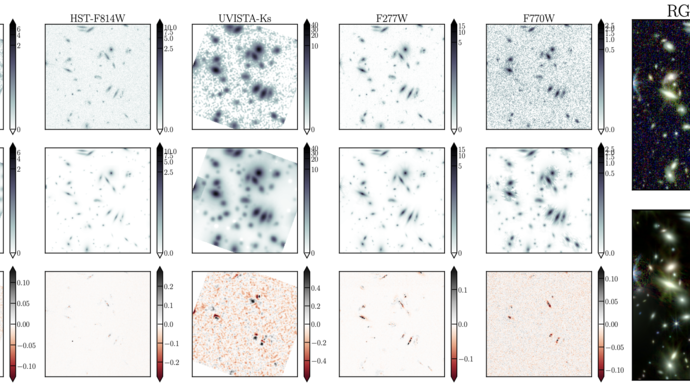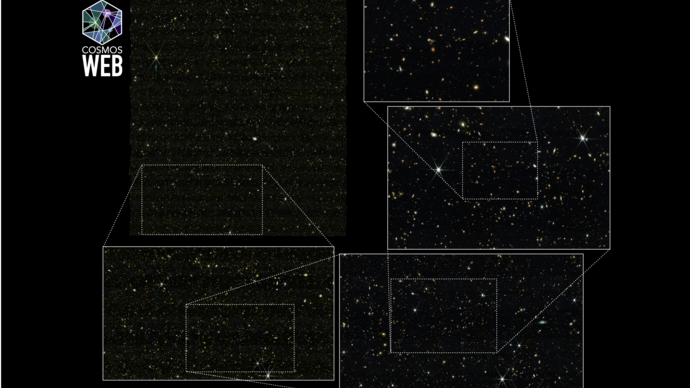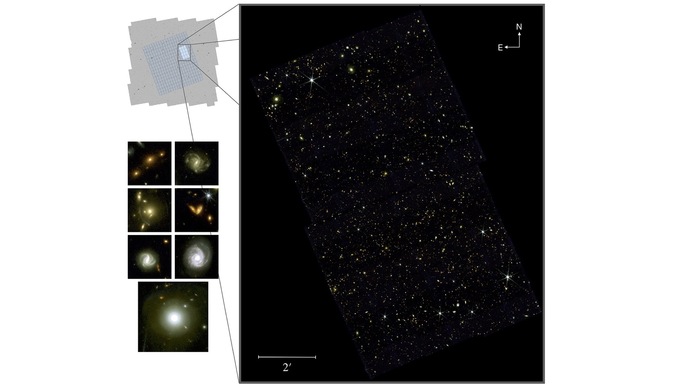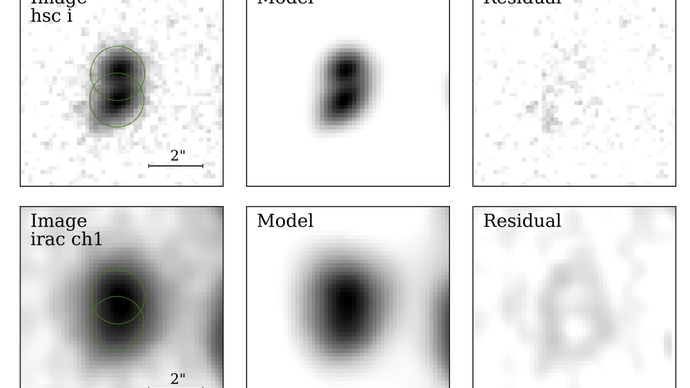About Us
The Cosmic Evolution Survey (COSMOS) is an astronomical survey designed to probe the formation and evolution of galaxies as a function of both cosmic time (redshift) and the local galaxy environment. The survey covers a 2 square degree equatorial field with spectroscopy and X-ray to radio imaging by most of the major space-based telescopes and a number of large ground based telescopes. Over 2 million galaxies are detected, spanning 75% of the age of the Universe. COSMOS is led by Caitlin Casey, Jeyhan Kartaltepe, and Vernesa Smolcic and involves more than 200 scientists in a dozen countries. More information on the COSMOS team members can be found here.
Any questions? - Contact us using this form.
Stay up-to-date! - Like us on Facebook, follow us on Twitter, Instagram, TikTok, and Reddit, or subscribe to our Youtube channel.
Spotlight
The COSMOS Spectroscopic Redshift Compilation -- 20 years of Spectroscopy to Guide the Future

The spatial spectroscopic completeness of the compilation limited to 𝑖 < 24 mag (top) and 𝐾𝑠 < 22.5 mag (bottom) with the full (high quality) sample shown on the left (right) panels. Each numerical value corresponds to the spectroscopic completeness of that specific 0.01 deg^2 region. The central region has the highest spectroscopic completeness due to the many follow-up programs focused on the CANDELS HST/ACS (light red) and WFC3 (red) region.
The COSMOS2025 Catalog — A New Window into the Universe
Last week, we released the COSMOS2025 galaxy catalog from the COSMOS-Web survey, offering photometric and physical measurements for nearly 800,000 galaxies across 0.54 square degrees of sky — roughly the area covered by three full moons. This represents the largest and deepest survey of its kind to date and opens the door to a wealth of new discoveries about our Universe.

Demonstration of the performance of our cataloging methodology with SourceXtractor++ over a relatively crowded and randomly selected 20′′ × 20′′ area. The top/middle/bottom rows show the science/model/residual images in five wide filters: HSC g, HST/ACS F814W, UltraVISTA KS , NIRCam F277W and MIRI F770W.
COSMOS-Web Unveils Largest Look Ever Into the Deep Universe
COSMOS-Web provides the largest view deep into the universe ever, and now all of its data are available publicly in an easily searchable format.
COSMOS-Web was the largest General Observer program selected for Cycle 1 of the James Webb Space Telescope (JWST). The survey mapped 0.54 square degrees of the sky (about the area of three full moons) with the Near Infrared Camera (NIRCam) and a 0.2 square degree area with the Mid Infrared Instrument (MIRI). The deep imaging comes with a catalog (the “COSMOS2025” catalog), which contains photometry, structural measurements, redshifts, and physical parameters for nearly 800,000 galaxies. Thanks to JWST imaging and previous COSMOS data, the catalog opens many unexplored scientific avenues.
Along with the data itself and three initial papers on the catalog, near infrared imaging, and mid infrared imaging, the data release so includes an interactive viewer where users can directly search images for specific objects or click on objects to see their properties. The COSMOS-Web images, catalog, and interactive viewer are available through the team’s data release website.

COSMOS-Web NIRCam mosaic (upper left) with zoom-ins to the region surrounding the COSMOS-Web Ring.
Press Release on First Epoch of COSMOS-Web Imaging
The first images from the largest program in the James Webb Space Telescope’s first year show many types of galaxies, including dazzling examples of spiral galaxies, gravitational lensing, and evidence of galaxy mergers. Scientists from the COSMOS-Web program released mosaic images taken in early January by JWST’s Near-Infrared Camera (NIRCam) and Mid-Infrared Instrument (MIRI).
COSMOS-Web aims to map the earliest structures of the universe and will create a wide and deep survey of up to 1 million galaxies. Over the course of 255 hours of observing time, COSMOS-Web will map 0.6 square degrees of the sky with NIRCam, roughly the size of three full moons, and 0.2 square degrees with MIRI.

The first epoch of COSMOS-Web NIRCam observations obtained on Jan. 5-6, 2023, including the F115W, F150W, F277W, and F444W filters as a color composite. These data cover six visits or pointings out of a total of 152 visits. The total area covered by NIRCam here is ∼77arcmin^2. The relative position of this mosaic in the survey is shown at upper left. At lower left are several zoomed-in 10′′ × 10′′ cutouts and one 16′′ × 16′′ cutout showing specific galaxies selected from these first data. Image credit: COSMOS-Web/Kartaltepe, Casey, Franco, Larson, et al./RIT/UT Austin/CANDIDE
COSMOS-Web overview paper is out!
- discover and characterize thousands of galaxies in the Epoch of Reionization (6 < z < 11)
- identify and study hundreds of rare quiescent galaxies at z > 4 and
- directly measure the evolution of the stellar mass to halo mass relation out to z ~ 2.5.
Nick Scoville elected to National Academy of Sciences
Nick Scoville, the Francis L. Moseley Professor of Astronomy at Caltech (Emeritus), was recently elected to the National Academy of Sciences in recognition of his distinguished and continuing achievements in original research! Nick is the PI of the original COSMOS HST/ACS observations. Congratulations!
New COSMOS catalog is out!
The new COSMOS catalog is out and its accompanying paper is accepted!
The catalog contains 1 million sources measured in more than 30 photometric bands from the UV to the infrared. For the extraction of the photometry, our international team applied a new prior-based method to go even deeper and to obtain more robust measurements for blended sources. The catalog also contains photometric redshifts and other physical properties of the galaxies measured from their photometry using spectral energy distribution (SED) fitting codes like LePhare and Eazy.
This catalog is a major milestone for COSMOS, combining its multi-wavelength data consistently, and opening up new avenues to explore galaxy evolution.
You can download the catalog at https://cosmos2020.calet.org to use it for your own science!

For the extraction of the photometry of the galaxies, a new prior-based method is used to go even deeper and to obtain more robust measurements for blended sources. Credit: J. Weaver et al. (2021).
Extended radio AGN and how they bend it
A team of COSMOS researchers studied jets escaping active galactic nuclei (AGN) to investigate what causes their bending. For this, they used radio data from the VLA and X-ray observations from Chandra/XMM-Newton to measure the "bent angle", i.e., the angle the jets form to each other in a two-sided source. The angle is related to the environment in which the AGN hosts reside and compared to magnetohydrodynamic simulations. It is found that the evolution of the environment surrounding the sources affects their radio structures and allows for more space for jet interactions.
COSMOS-Webb selected as JWST’s largest Cycle 1 program
When the James Webb Space Telescope (JWST)—the long-awaited successor to the Hubble Space Telescope—becomes operational in 2022, one of its first orders of business will be mapping the earliest structures of the universe. A team of nearly 50 researchers led by scientists at Rochester Institute of Technology and University of Texas at Austin will attempt to do so through the COSMOS-Webb program, the largest General Observer program selected for JWST’s first year.
Over the course of 208.6 observing hours, the COSMOS-Webb program will conduct an ambitious survey of half a million galaxies with multi-band, high-resolution near infrared imaging and an unprecedented 32,000 galaxies in mid infrared. The scientists involved said that because COSMOS-Webb is a treasury program, they will rapidly release data to the public so it can lead to countless other studies by other researchers.

The COSMOS-Webb survey will map 0.6 square degrees of the sky—about the area of three full moons—using JWST’s Near Infrared Camera (NIRCam) instrument while simultaneously mapping a smaller 0.2 square degrees with the Mid Infrared Instrument (MIRI). Credit: J. Kartaltepe/RIT; C. Casey/UT Austin; A. Koekemoer/STScI














